1. Bouchard C. Genomic predictors of trainability. Exp Physiol. 2012; 97:347–352. PMID:
21967902.

2. Lippi G, Longo UG, Maffulli N. Genetics and sports. Br Med Bull. 2010; 93:27–47. PMID:
19208613.

3. Pérusse L, Rankinen T, Rauramaa R, Rivera MA, Wolfarth B, Bouchard C. The human gene map for performance and health-related fitness phenotypes: the 2002 update. Med Sci Sports Exerc. 2003; 35:1248–1264. PMID:
12900676.
4. Rankinen T, Roth SM, Bray MS, Loos R, Pérusse L, Wolfarth B, Hagberg JM, Bouchard C. Advances in exercise, fitness, and performance genomics. Med Sci Sports Exerc. 2010; 42:835–846. PMID:
20400881.

5. Abraham MR, Olson LJ, Joyner MJ, Turner ST, Beck KC, Johnson BD. Angiotensin-converting enzyme genotype modulates pulmonary function and exercise capacity in treated patients with congestive stable heart failure. Circulation. 2002; 106:1794–1799. PMID:
12356632.

6. Chiu L, Hsieh L, Yen K, Hseieh SS. Ace I/D And Actn3 R577x Polymorphism In Elite Athletes. Med Sci Sports Exerc. 2005; 37:167–174.

7. Gayagay G, Yu B, Hambly B, Boston T, Hahn A, Celermajer DS, Trent RJ. Elite endurance athletes and the ACE I allele--the role of genes in athletic performance. Hum Genet. 1998; 103:48–50. PMID:
9737775.
8. Scott RA, Irving R, Irwin L, Morrison E, Charlton V, Austin K, Tladi D, Deason M, Headley SA, Kolkhorst FW, Yang N, North K, Pitsiladis YP. ACTN3 and ACE genotypes in elite Jamaican and US sprinters. Med Sci Sports Exerc. 2010; 42:107–112. PMID:
20010124.

9. Taylor RR, Mamotte CD, Fallon K, van Bockxmeer FM. Elite athletes and the gene for angiotensin-converting enzyme. J Appl Physiol. 1999; 87:1035–1037. PMID:
10484574.
10. Strazzullo P, Iacone R, Iacoviello L, Russo O, Barba G, Russo P, D'Orazio A, Barbato A, Cappuccio FP, Farinaro E, Siani A. Olivetti Prospective Heart Study. Genetic variation in the renin-angiotensin system and abdominal adiposity in men: the Olivetti Prospective Heart Study. Ann Intern Med. 2003; 138:17–23. PMID:
12513040.

11. Puthucheary Z, Skipworth JR, Rawal J, Loosemore M, Van Someren K, Montgomery HE. The ACE gene and human performance: 12 years on. Sports Med. 2011; 41:433–448. PMID:
21615186.
12. MacArthur DG, North KN. A gene for speed? The evolution and function of alpha-actinin-3. Bioessays. 2004; 26:786–795. PMID:
15221860.
13. Yang N, MacArthur DG, Gulbin JP, Hahn AG, Beggs AH, Easteal S, North K. ACTN3 genotype is associated with human elite athletic performance. Am J Hum Genet. 2003; 73:627–631. PMID:
12879365.

14. Zanoteli E, Lotuffo RM, Oliveira AS, Beggs AH, Canovas M, Zatz M, Vainzof M. Deficiency of muscle alpha-actinin-3 is compatible with high muscle performance. J Mol Neurosci. 2003; 20:39–42. PMID:
12663933.
15. Eider J, Cieszczyk P, Ficek K, Leonska-Duniec A, Sawczuk M, Maciejewska-Karlowska A, Zarebska A. The association between D allele of the ACE gene and power performance in Polish elite athletes. Sci Sports. 2013; 28:325–333.

16. Williams AG, Folland JP. Similarity of polygenic profiles limits the potential for elite human physical performance. J Physiol. 2008; 586:113–121. PMID:
17901117.

17. Gómez-Gallego F, Santiago C, González-Freire M, Muniesa CA, Fernández Del Valle M, Pérez M, Foster C, Lucia A. Endurance performance: genes or gene combinations? Int J Sports Med. 2009; 30:66–72. PMID:
18651373.

18. Grenda A, Leońska-Duniec A, Kaczmarczyk M, Ficek K, Król P, Cięszczyk P, Zmijewski P. Interaction between ACE I/D and ACTN3 R557X polymorphisms in polish competitive swimmers. J Hum Kinet. 2014; 42:127–136. PMID:
25414746.

19. Kim K. Association of angiotensin-converting enzyme insertion/deletion polymorphism with obesity, cardiovascular risk factors and exercise-mediated changes in Korean women. Eur J Appl Physiol. 2009; 105:879–887. PMID:
19125277.

20. Mondry A, Loh M, Liu P, Zhu AL, Nagel M. Polymorphisms of the insertion / deletion ACE and M235T AGT genes and hypertension: surprising new findings and meta-analysis of data. BMC Nephrol. 2005; 6:1. PMID:
15642127.

21. Wang JG, He X, Wang GL, Li Y, Zhou HF, Zhang WZ, Zhan YM, Zhu DL. Family-based associations between the angiotensinconverting enzyme insertion/deletion polymorphism and multiple cardiovascular risk factors in Chinese. J Hypertens. 2004; 22:487–491. PMID:
15076153.
22. Agerholm-Larsen B, Nordestgaard BG, Tybjaerg-Hansen A. ACE gene polymorphism in cardiovascular disease: metaanalyses of small and large studies in whites. Arterioscler Thromb Vasc Biol. 2000; 20:484–492. PMID:
10669647.
23. Harrap SB, Tzourio C, Cambien F, Poirier O, Raoux S, Chalmers J, Chapman N, Colman S, Leguennec S, MacMahon S, Neal B, Ohkubo T, Woodward M. PROGRESS Collaborative Group. The ACE gene I/D polymorphism is not associated with the blood pressure and cardiovascular benefits of ACE inhibition. Hypertension. 2003; 42:297–303. PMID:
12925557.
24. Pitsiladis Y, Wang G, Wolfarth B, Scott R, Fuku N, Mikami E, He Z, Fiuza-Luces C, Eynon N, Lucia A. Genomics of elite sporting performance: what little we know and necessary advances. Br J Sports Med. 2013; 47:550–555. PMID:
23632745.

25. MacArthur DG, North KN. The ACTN3 gene and performance. In : Bouchard C, Hoffman EP, editors. Genetic and Molecular Aspects of Sports. Wiley-Blackwell Oxford UK;2011. doi:
10.1002/9781444327335.ch18.
26. Teran-Garcia M, Rankinen T, Bouchard C. Genes, exercise, growth, and the sedentary, obese child. J Appl Physiol. 2008; 105:988–1001. PMID:
18535128.

27. Woods D, Hickman M, Jamshidi Y, Brull D, Vassiliou V, Jones A, Humphries S, Montgomery H. Elite swimmers and the D allele of the ACE I/D polymorphism. Hum Genet. 2001; 108:230–232. PMID:
11354635.

28. Montgomery HE, Marshall R, Hemingway H, Myerson S, Clarkson P, Dollery C, Hayward M, Holliman DE, Jubb M, World M, Thomas EL, Brynes AE, Saeed N, Barnard M, Bell JD, Prasad K, Rayson M, Talmud PJ, Humphries SE. Human gene for physical performance. Nature. 1998; 393:221–222. PMID:
9607758.

29. Collins M, Xenophontos SL, Cariolou MA, Mokone GG, Hudson DE, Anastasiades L, Noakes TD. The ACE gene and endurance performance during the South African Ironman Triathlons. Med Sci Sports Exerc. 2004; 36:1314–1320. PMID:
15292738.

30. Myerson S, Hemingway H, Budget R, Martin J, Humphries S, Montgomery H. Human angiotensin I-converting enzyme gene and endurance performance. J Appl Physiol. 1999; 87:1313–1316. PMID:
10517757.
31. Giaccaglia V, Nicklas B, Kritchevsky S, Mychalecky J, Messier S, Bleecker E, Pahor M. Interaction between angiotensin converting enzyme insertion/deletion genotype and exercise training on knee extensor strength in older individuals. Int J Sports Med. 2008; 29:40–44. PMID:
17614015.

32. Hopkinson NS, Nickol AH, Payne J, Hawe E, Man WD, Moxham J, Montgomery H, Polkey MI. Angiotensin converting enzyme genotype and strength in chronic obstructive pulmonary disease. Am J Respir Crit Care Med. 2004; 170:395–399. PMID:
15117739.

33. Yamin C, Amir O, Sagiv M, Attias E, Meckel Y, Eynon N, Sagiv M, Amir RE. ACE ID genotype affects blood creatine kinase response to eccentric exercise. J Appl Physiol. 2007; 103:2057–2061. PMID:
17885020.

34. Ash GI, Scott RA, Deason M, Dawson TA, Wolde B, Bekele Z, Teka S, Pitsiladis YP. No association between ACE gene variation and endurance athlete status in Ethiopians. Med Sci Sports Exerc. 2011; 43:590–597. PMID:
20798657.

35. Zhao B, Moochhala SM, Tham Sy, Lu J, Chia M, Byrne C, Hu Q, Lee LK. Relationship between angiotensin-converting enzyme ID polymorphism and VO2max of Chinese males. Life Sci. 2003; 73:2625–2630. PMID:
12967686.

36. Amir O, Amir R, Yamin C, Attias E, Eynon N, Sagiv M, Sagiv M, Meckel Y. The ACE deletion allele is associated with Israeli elite endurance athletes. Exp Physiol. 2007; 92:881–886. PMID:
17631516.
37. Kim CH, Cho JY, Jeon JY, Koh YG, Kim YM, Kim HJ, Park M, Um HS, Kim C. ACE DD genotype is unfavorable to Korean short-term muscle power athletes. Int J Sports Med. 2010; 31:65–71. PMID:
20029740.
38. Ahmetov II, Druzhevskaya AM, Astratenkova IV, Popov DV, Vinogradova OL, Rogozkin VA. The ACTN3 R577X polymorphism in Russian endurance athletes. Br J Sports Med. 2010; 44:649–652. PMID:
18718976.

39. Clarkson PM, Devaney JM, Gordish-Dressman H, Thompson PD, Hubal MJ, Urso M, Price TB, Angelopoulos TJ, Gordon PM, Moyna NM, Pescatello LS, Visich PS, Zoeller RF, Seip RL, Hoffman EP. ACTN3 genotype is associated with increases in muscle strength in response to resistance training in women. J Appl Physiol. 2005; 99:154–163. PMID:
15718405.

40. Delmonico MJ, Kostek MC, Doldo NA, Hand BD, Walsh S, Conway JM, Carignan CR, Roth SM, Hurley BF. Alpha-actinin-3 (ACTN3) R577X polymorphism influences knee extensor peak power response to strength training in older men and women. J Gerontol A Biol Sci Med Sci. 2007; 62:206–212. PMID:
17339648.

41. Norman B, Esbjörnsson M, Rundqvist H, Osterlund T, von Walden F, Tesch PA. Strength, power, fiber types, and mRNA expression in trained men and women with different ACTN3 R577X genotypes. J Appl Physiol. 2009; 106:959–965. PMID:
19150855.
42. Lucia A, Gómez-Gallego F, Santiago C, Bandrés F, Earnest C, Rabadán M, Alonso JM, Hoyos J, Córdova A, Villa G, Foster C. ACTN3 genotype in professional endurance cyclists. Int J Sports Med. 2006; 27:880–884. PMID:
16612741.

43. Paparini A, Ripani M, Giordano GD, Santoni D, Pigozzi F, Romano-Spica V. ACTN3 genotyping by real-time PCR in the Italian population and athletes. Med Sci Sports Exerc. 2007; 39:810–815. PMID:
17468578.
44. Saunders CJ, September AV, Xenophontos SL, Cariolou MA, Anastassiades LC, Noakes TD, Collins M. No association of the ACTN3 gene R577X polymorphism with endurance performance in Ironman Triathlons. Ann Hum Genet. 2007; 71:777–781. PMID:
17627799.

45. Yang N, MacArthur DG, Wolde B, Onywera VO, Boit MK, Lau SY, Wilson RH, Scott RA, Pitsiladis YP, North K. The ACTN3 R577X polymorphism in East and West African athletes. Med Sci Sports Exerc. 2007; 39:1985–1988. PMID:
17986906.

46. Ahmetov II, Popov DV, Astratenkova IV, Druzhevskaya AM, Missina SS, Vinogradova OL, Rogozkin VA. The use of molecular genetic methods for prognosis of aerobic and anaerobic performance in athletes. Hum Physiol. 2008; 34:338–342.
47. Rodríguez-Romo G, Ruiz JR, Santiago C, Fiuza-Luces C, González-Freire M, Gómez-Gallego F, Morán M, Lucia A. Does the ACE I/D polymorphism, alone or in combination with the ACTN3 R577X polymorphism, influence muscle power phenotypes in young, non-athletic adults? Eur J Appl Physiol. 2010; 110:1099–1106. PMID:
20734058.

48. Eynon N, Alves AJ, Yamin C, Sagiv M, Duarte JA, Oliveira J, Ayalon M, Goldhammer E, Sagiv M, Meckel Y. Is there an ACE ID - ACTN3 R577X polymorphisms interaction that influences sprint performance? Int J Sports Med. 2009; 30:888–891. PMID:
20013558.
49. Bustamante-Ara N, Santiago C, Verde Z, Yvert T, Gómez-Gallego F, Rodríguez-Romo G, González-Gil P, Serra-Rexach JA, Ruiz JR, Lucia A. ACE and ACTN3 genes and muscle phenotypes in nonagenarians. Int J Sports Med. 2010; 31:221–224. PMID:
20148371.
50. Bonjour JP, Chevalley T, Rizzoli R, Ferrari S. Geneenvironment interactions in the skeletal response to nutrition and exercise during growth. Med Sport Sci. 2007; 51:64–80. PMID:
17505120.

51. Bradney M, Pearce G, Naughton G, Sullivan C, Bass S, Beck T, Carlson J, Seeman E. Moderate exercise during growth in prepubertal boys: changes in bone mass, size, volumetric density, and bone strength: a controlled prospective study. J Bone Miner Res. 1998; 13:1814–1821. PMID:
9844098.

52. Malina RM. Physical growth and biological maturation of young athletes. Exerc Sport Sci Rev. 1994; 22:389–433. PMID:
7925550.

53. van Lenthe FJ, Kemper CG, van Mechelen W. Rapid maturation in adolescence results in greater obesity in adulthood: the Amsterdam Growth and Health Study. Am J Clin Nutr. 1996; 64:18–24. PMID:
8669409.

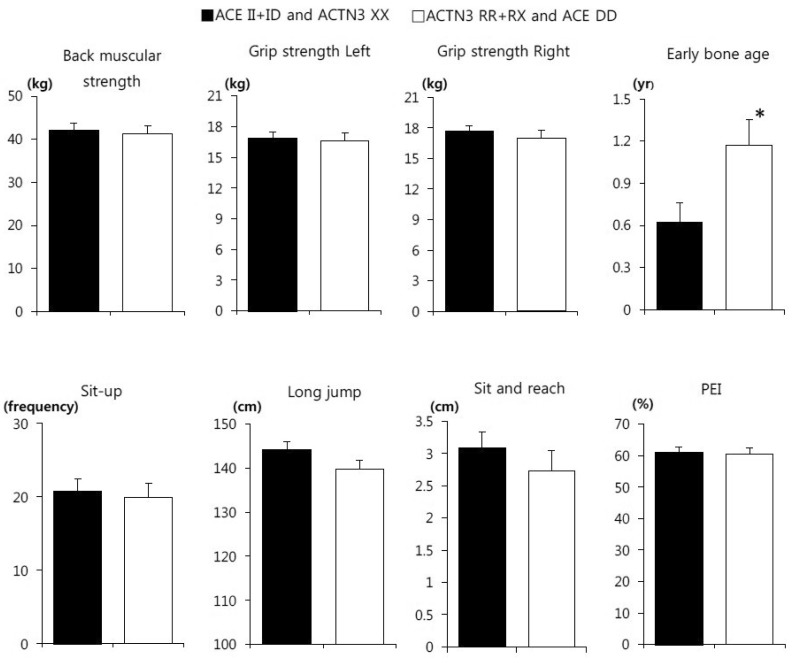
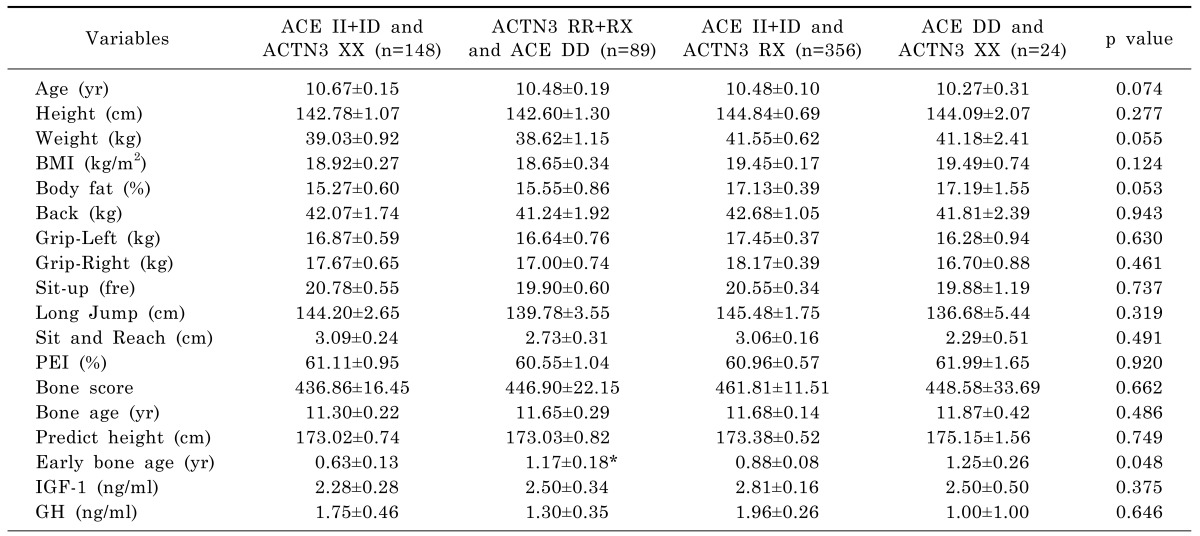




 PDF
PDF ePub
ePub Citation
Citation Print
Print


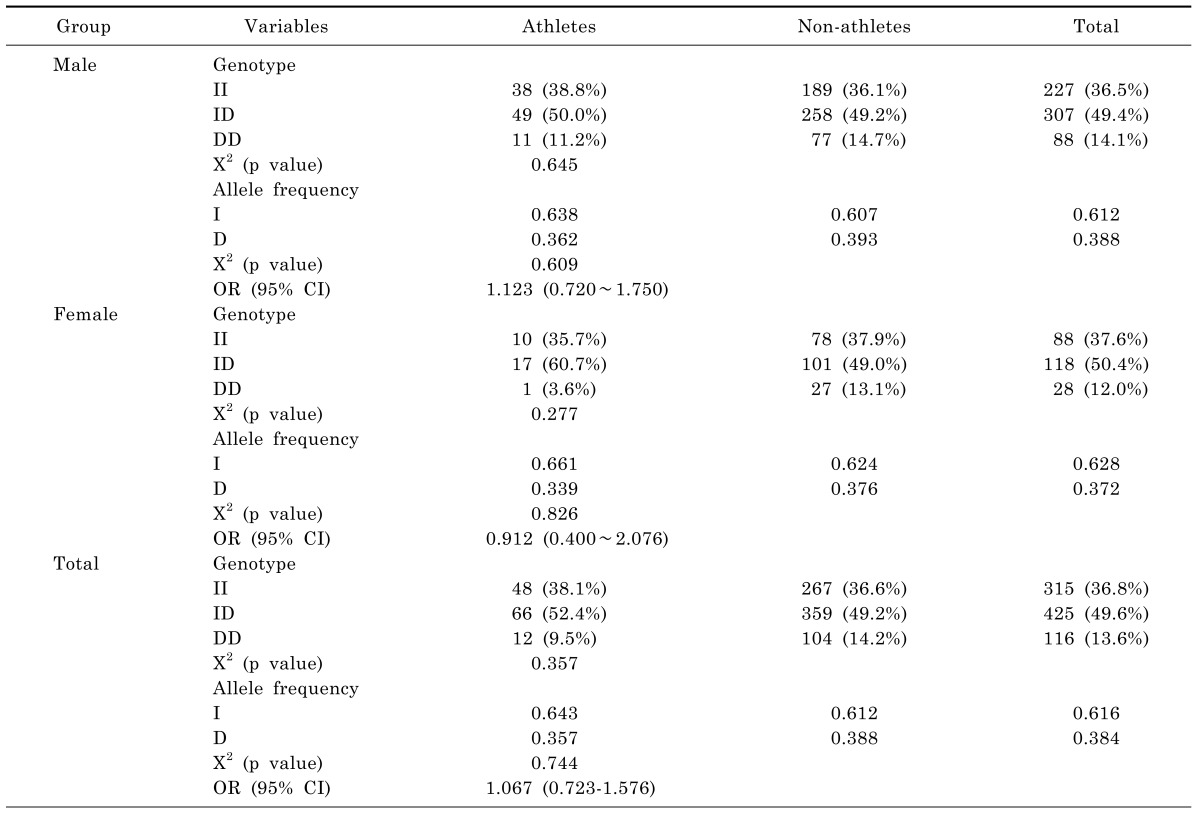
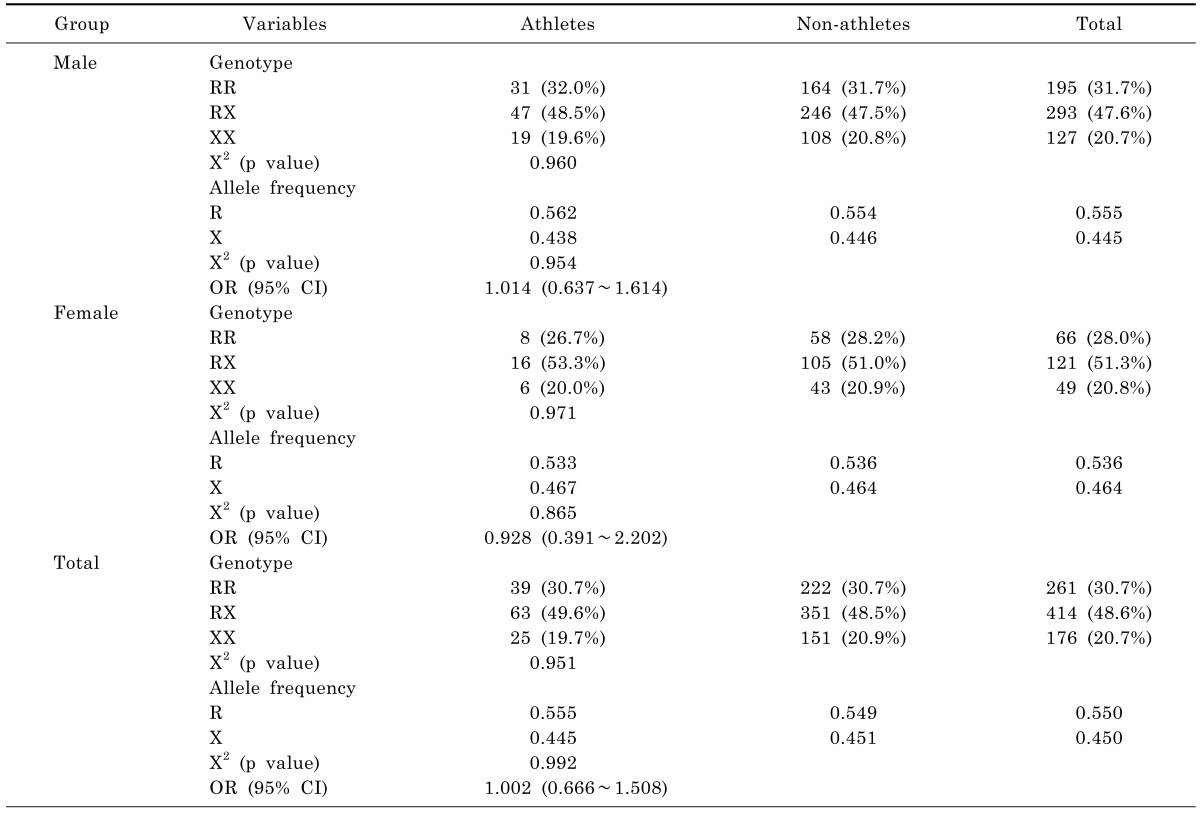
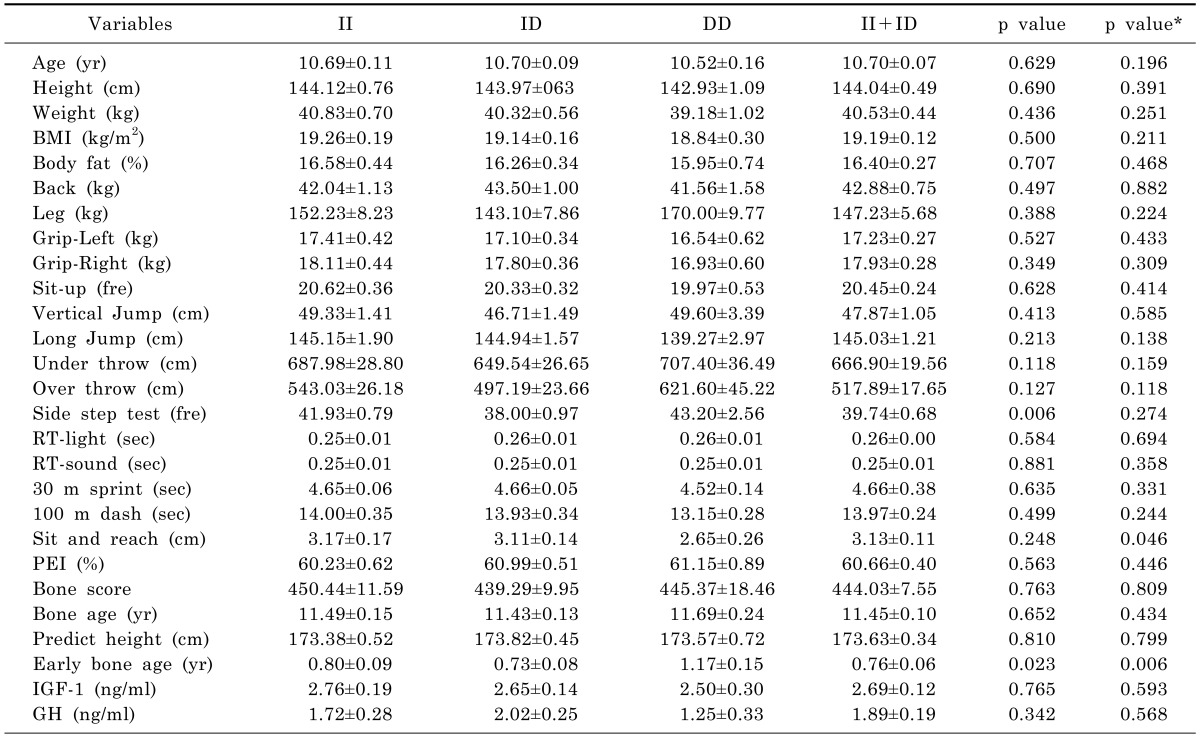


 XML Download
XML Download